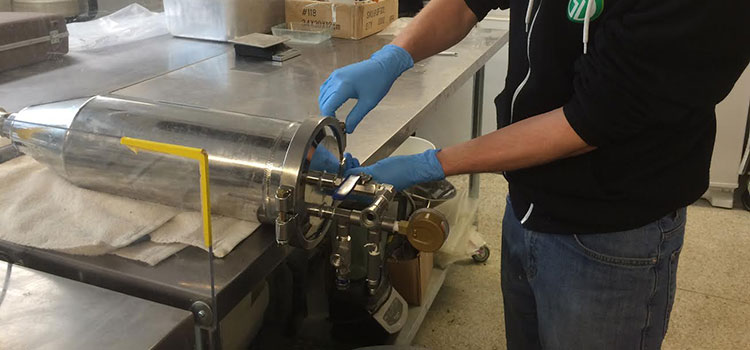Cannabis extraction is a complex process, and could be considered dangerous without proper preparation.
Considering the most important safety precautions for any extract production facility, we should first identify the most common risks of extraction. Only by recognizing these process risks can the right steps be followed to ensure the safety of both employees and products.
Fire
Let’s begin with the obvious. When dealing with flammable gasses or liquids in extract production, there is a risk of fire or explosion during the handling process. The easiest way to understand the risk of fire or explosion is to consider the fire triangle. Essentially, a fire needs three things to start: a fuel source, oxygen, and an ignition source. The basic philosophy here is that by removing legs from the fire triangle, we can make the process safer; by removing two legs, an operator can make their extraction process significantly less incident-prone.
First, accomplish process isolation through the utilization of a proper enclosure, such as a vented hood, which will suck out vapors, removing a fuel source. Conducting extraction operations inside an enclosure with no available ignition sources removes one leg from the fire triangle, adding ventilation removes another. Finally, there are two tools that should be kept on site to make known the presence of unnoticed flammable vapors: a permanent LEL, or Lower Explosive Limit, monitor should be installed in the extraction room; and a handheld two or four gas portable monitor should be on site as well.
CO2 Exposure
The next identifiable risk is specific to carbon dioxide extractions. Running a CO2 extraction can release a dangerous asphyxiating gas that can lead to unconsciousness and death if it goes unnoticed. Arguably the simplest way to avoid CO2 exposure is to prevent its release from the point of operation before it can become a problem. Therefore, all emergency relief valves should be piped to the outside of the building. Conducting CO2 extractions in a room with proper ventilation is the best place to start safe-proofing the operation. Compliment this with the installation of a CO2 concentration monitor, which will offer ample time for operators to take evasive measures in the event of a leak. Concentration monitors will give a warning alarm sound at the OSHA-recommended 5,000 PPM, well below the Immediately Dangerous to Life limit of 50,000 PPM. Thus, if the alarm sounds, operators should be trained in taking action to isolate the operation and evacuate the area before a lethal amount of the gas is present.
Cannabis Dust
Sometimes overlooked, operators of extraction facilities should also be weary of their employees being exposed to cannabis dust. These small particles can go unnoticed throughout the day, but their short and long term impacts can lead to serious health complications. There are two ways to combat dust-related health concerns. The first option is the installation of point-source ventilation. Working with trim or other dust-heavy materials with proper ventilation installed will effectively remove excess air particles from the area of operation. The second option is to make it a standard operating procedure step to wear NIOSH approved N95 disposable respirators.
Harmful Vapors
Even after the extraction process is completed, there are concerns that must be alleviated. The solvents used to produce cannabis-infused oils, such as isopropyl alcohol, heptane or ethanol, can produce harmful vapors if employees are over exposed. A facility should use either point-source ventilation or a dedicated ventilation system for this step of the production cycle to effectively remove vapors from the operation area. Additionally, following OSHA occupational limits for exposure to these vapors will keep operators safe from the threat of overexposure.
Hearing Loss
Finally, perhaps the most commonly overlooked risk in an extraction production process is also the easiest to alleviate. When running extraction machines, operators are often exposed to a high level of noise. As one might expect, the simplest solution is to ensure that wearing OSHA approved noise-cancelling earplugs, earmuffs or hearing bands are included in standard operating procedures. They only need to be worn during high-noise-level stages of production, but can guarantee lifelong safety of operators’ hearing. Hearing bands are best for labor-intensive operations, as they can quickly be slung around an operator’s neck when not in use.
Identifying risks in an extraction facility isn’t a small task, but it’s necessary to keep operations safe and sound. Some solutions to identifying risks might have seemingly high initial costs, like the installation of gas monitors or significant changes to standard operating procedures. However, keep in mind that theses costs are relatively small when they guarantee the safety of your operators.
